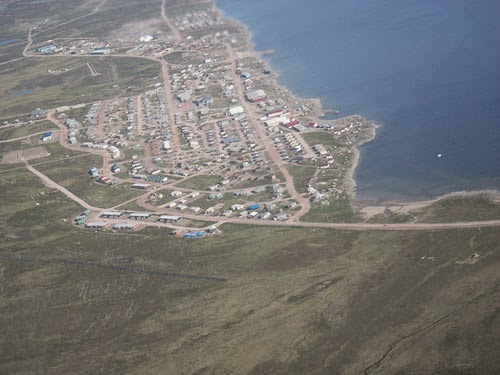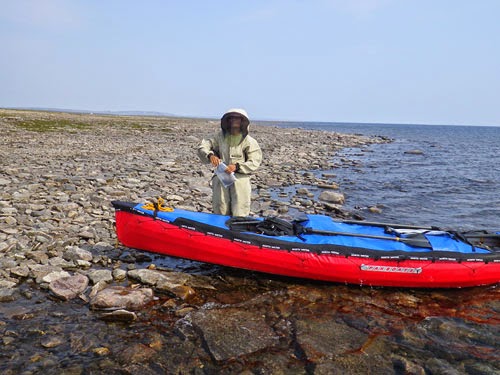Weather: Calm, cloudy, buggy, then rain and a thunderstorm
Distance: 37 km
Location: Latitude:64.31686, Longitude:-96.05016 at 08/05/2014 14:27:35 PDT
Map link:
Click here
It was a cold night. The temperature dropped to freezing and there was ice on the tent in places and a heavy dew. The black flies seemed dead, but they gradually sprang to life as the sun warmed them up. We stayed in bed late and didn't start paddling until after 10 am. The current was quite strong in places and there were some significant rapids as we approached the estuary of Baker Lake. These were not marked, but were in some ways more challenging than Aleksektok Rapids. I think this was the only place on the entire journey where we actually took some water in the canoe due to poor timing with a breaking wave.
The other thing that was tricky was selecting the correct channel. The river is very large as it approaches Baker Lake and it spreads out in a maze of channels, gravel bars and sand spits. There a numerous rapids in the channels as the shallow water cascades over the rocks. We wondered if it might normally be smoother with a higher river discharge.
We arrived in Baker Lake around 2pm. Kirti walked in to the airport as we passed it on the way in to Baker Lake, and managed to book our flight back to Yellowknife (via Rankin Inlet) for the following afternoon. The ticket prices were much more reasonable than we had anticipated.
We found the camp site and set up our tent just in time for the rain to start. Everything got soaked before we could pack it away. Then we walked into Baker Lake to explore the town. People were very nice and we managed to get a shower at the local swimming pool. Unfortunately, there was no place open to eat after 6pm, but we had plenty of food left so we cooked our own dinner as usual.
Shortly after we arrived in Baker Lake, so did 4 other groups from Camp Menogyn. One group had run the Thelon, another had done the Hanbury, a third did the Kazan, and the fourth did the Back and Bailey. They had all been out for 37-40 days. The beach in front of the canoe camp was packed with canoes. Local people from Baker Lake came down to the camp to meet all the visitors. The local people are wonderfully friendly.
There was a huge thunder storm at night, right over the top of us. The thunder was really loud in the tent.




























































